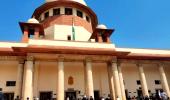'Presumption of innocence must guide all formal actions, but transparency must not be mistaken for pre-judgment.'
'The cruel irony, however, is that Justice Varma is a fine judge who enjoys a reputation for writing well-reasoned judgments.'

Ever since cash was allegedly found at then Delhi high court Justice Yashwant Varma's residence during a fire on March 14, there has been speculation about the higher judiciary, a hallowed space seen with awe.
While judges are not immune from prosecution under the Prevention of Corruption Act, 1988, FIRs cannot be registered against them without consultation with the Chief Justice of India, and Presidential sanction for prosecution can be done only on the CJI's advice.
Till date, no judge has been impeached in India, although one judge, Justice Soumitra Sen of the Calcutta high court, resigned in 2011 after the Rajya Sabha passed an impeachment motion against him.
"Sunlight is the best disinfectant and an accountability mechanism pre-dominated by judges and having members outside the legal fraternity is critical. After all, the impact of judges' work is felt far and wide, and consequently, the composition of any accountability body must reflect that," Dr Arghya Sengupta, Founder and Research Director at the Vidhi Centre for Legal Policy, an independent think-tank conducting legal research to improve governance and develop effective laws, tells Shobha John.
A Rhodes Scholar, Dr Sengupta's doctoral work at Oxford was on judicial independence and accountability.
Supreme Court Bar Association President Kapil Sibal had said that the Supreme Court's decision to make public an internal probe report by three judges on Justice Varma sets a dangerous precedent.
What is your opinion? Should the public know the contents of this report, especially since videos and photographs of the cash burnt in the fire have been made public?
Transparency is a constitutional virtue, especially when public trust is at stake.
While disclosures of this kind must be carefully balanced against fairness to the judge in question, in cases where public interest is already stirred, publication of a factual report is an entirely defensible position.
It prevents speculation and builds institutional credibility.
However, it would have been better if the alleged video showing stacks of burning cash was not released without proper verification.
There is a difference between a probe report, which ought to be disclosed for fairness and building public confidence, and an unverified video which only fuels speculation.
Do you think the media glare on this case has been too much considering Justice Varma has not been pronounced guilty?
Yes, the media spotlight has been intense. Judicial accountability must proceed with due process, not trial by media.
But when public faith is shaken, responsible media coverage becomes a necessary part of democratic scrutiny.
Presumption of innocence must guide all formal actions, but transparency must not be mistaken for pre-judgment.
The cruel irony, however, is that Justice Varma is a fine judge who enjoys a reputation for writing well-reasoned judgments.
The media frenzy has irreparably ruined his reputation.

Also, is it proper for judges to judge fellow judges? Such an in-house mechanism may seem ineffective.
The in-house mechanism reflects the judiciary's attempt at self-regulation, but suffers from opacity and lacks procedural rigour. It is at best a stop-gap measure.
Internal mechanisms must be complemented by an independent institutional body rooted in transparency and legitimacy.
The current approach is based on giving primacy to judicial independence, but neither absolute independence in terms of degree nor independence regarding all aspects of judicial functioning is desirable.
Sunlight is the best disinfectant and an accountability mechanism predominated by judges and having members outside the legal fraternity is critical.
After all, the impact of judges' work is felt far and wide, and consequently, the composition of any accountability body must reflect that.
Under the Constitution, a judge can only be impeached by Parliament. But should a permanent and transparent institutional mechanism be put in place to deal with cases of financial corruption, sexual misdemeanours or alignment of judges with a particular ideology?
Who should be part of this mechanism?
Absolutely. Cases of corruption, sexual misconduct etc demand structured responses. An independent commission could be considered.
Its members should include retired judges, eminent jurists, and members of civil society, nominated through a credible process.
Impeachment can be the maximum penalty, but lesser forms of punishment -- public censure, suspension, forced leave, withdrawal of work, etc -- must be legislated.
The Justice Varma case also led to calls by politicians for reviving the National Judicial Appointments Commission to replace the Collegium.
But the Supreme Court had struck down the NJAC in 2015 saying it violated the basic structure of the Constitution as it undermined the independence of the judiciary.
The NJAC was a step in the right direction. The court flagged independence concerns, but by striking it down without offering an alternative, it entrenched into Indian constitutional law the concept of the Collegium -- an entity that may have been formulated with the right intention but is entirely discredited today.
A revised NJAC, ensuring meaningful participation of the judiciary, government and civil society is both possible and desirable.

Should there also be a legislation to mandatorily make all judges declare their assets in public?
According to official data, of around 1,133 judges in high courts and the Supreme Court, only 98 have declared assets.
Yes. Public declaration of assets should be mandatory for all judges. The abysmal compliance rate underscores the need for a statutory mechanism.
Accountability must begin with openness. It is good that Supreme Court judges have voluntarily decided to do this, but it should be legislated so that it becomes a mandatory requirement and not a temporary reaction to a crisis.
Is it not a fact that there are middlemen who facilitate corruption? Should there be focus on them also?
Absolutely. Judicial corruption often operates through intermediaries -- some advocates, fixers, or even some registry staff. These are well-known secrets in any judicial institution in India.
Any meaningful reform must dismantle this ecosystem. It will take time, but a start must be made.
Your thesis at Oxford was on judicial corruption. How common is it abroad and how have some countries dealt with it successfully?
My doctoral work at Oxford (2009-2014) focused on internal mechanisms of judicial accountability and the conceptual tensions between judicial independence on the one hand and judicial accountability on the other.
Other jurisdictions -- like the US Judicial Conduct and Disability Act or the UK's Judicial Conduct Investigations Office -- offer models of independent oversight with due process safeguards.
These demonstrate that accountability need not compromise independence.
Is corruption in the courts also fostered by the huge pendency of cases in subordinate and high courts?
Litigants often pay bribes to secure favourable hearing dates or expedite orders. How can this be mitigated?
Yes. Pendency breeds discretion, and discretion without oversight leads to rent-seeking.
Solutions include transparent listing protocols, real-time monitoring of case progress, strengthening court infrastructure, and reliance on technology for auto-listing to eliminate scope for 'fixing' hearings. There is much work to be done.

Will the Justice Varma case lead to judicial reform?
It should, but I doubt it will. The inflection point for the Indian judiciary was the unprecedented press conference of the four senior justices of the Supreme Court in January 2018.
In response to that, the judiciary closed ranks instead of choosing to reform itself.
It is doubtful whether now, when the crisis is much smaller, any meaningful reform will take place.
Would you agree with the view that when a judge is tainted, the whole institution is tainted?
Yes, but only if the institution does not respond. A credible and swift response can restore public faith. Silence, on the other hand, corrodes it.
In the US, we see judges standing up against President Donald Trump and some of his excesses. Do you think that would ever happen in India?
Indian judges have spoken through judgments, but rarely outside the courtroom. For sustained resistance, institutional independence must be matched by individual courage -- and structural reform.

Recently, it was reported that an Artificial Intelligence avatar tried to argue a case for a petitioner before a judge in the US.
Do you see AI being a game-changer or a disrupter in the legal profession?
AI will be a major disrupter in the legal profession in a positive way. I see three major uses of AI as well as smart use of technology:
First is easing administration. The judiciary is a colonial, bureaucratic system with unnecessary steps, complex processes and inordinate delays.
For example, research done by my colleagues found that it takes on average 273 days to deliver a summons in the suburbs of Bangalore (Bangalore Rural).
Imagine this in the hi-tech capital of India. This is where tech-based systems will lead to transformational change.
Secondly, there will be easing of judgment writing. Transcription, evidence-taking, case law searches are all time-consuming work for a judge.
AI will, and already is, helping judges, leaving time to do what only a judge can do -- decide on the basis of the facts and the law in a manner that exercises human judgement.
Third is automating routine cases, which do not need lengthy judicial time.
For example, motor accident claims are formulaic and can simply be done by an AI-powered machine.
A judge can sign off on the order to make sure there are no errors and patent injustice.
There can be similar use cases. Overall, AI and tech-usage will mark a paradigm shift in the judiciary, as in other fields.
The judiciary has shown openness towards adopting it, which is encouraging. But there is a long way to go.
Feature Presentation: Aslam Hunani/Rediff.com











 © 2025
© 2025